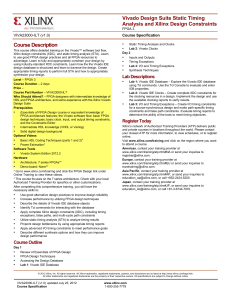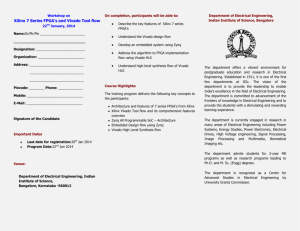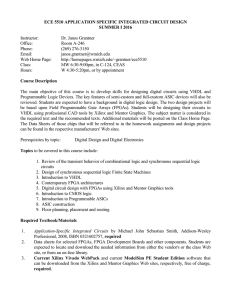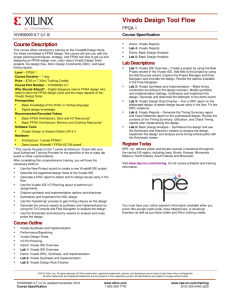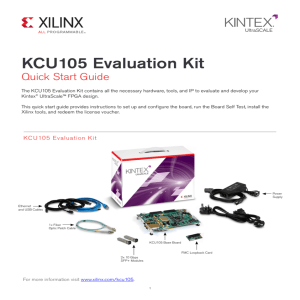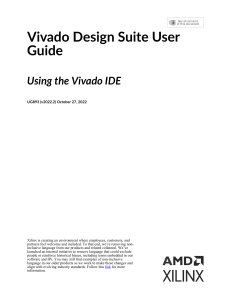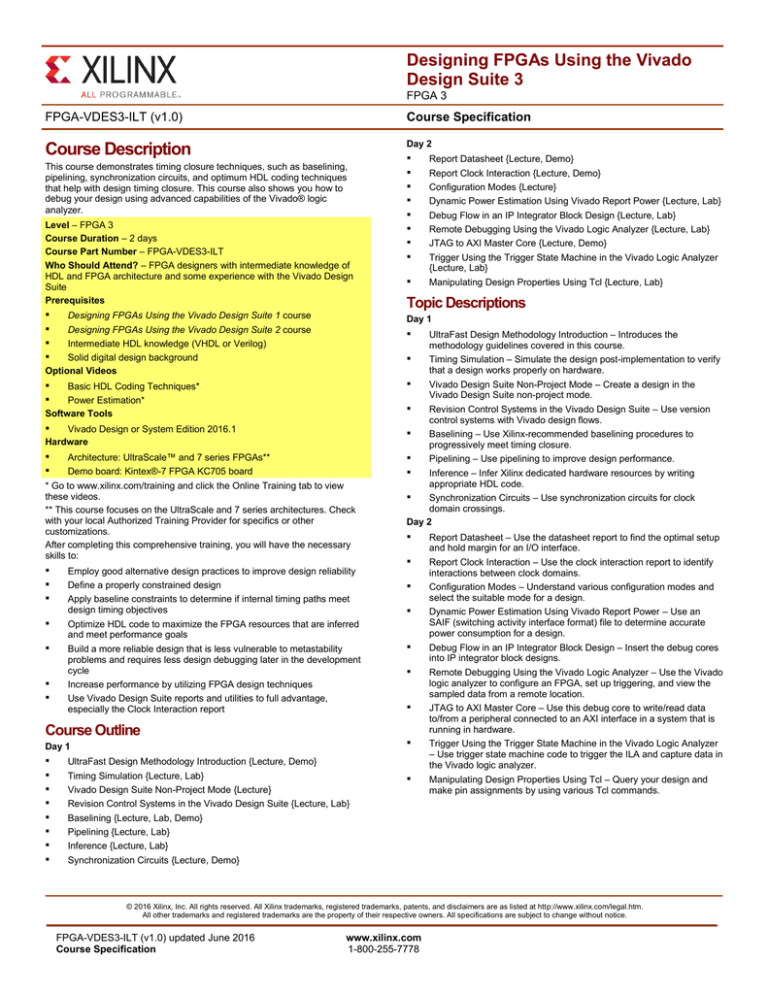
Designing FPGAs Using the Vivado
Design Suite 3
FPGA 3
FPGA-VDES3-ILT (v1.0)
Course Specification
Course Description
Day 2
This course demonstrates timing closure techniques, such as baselining,
pipelining, synchronization circuits, and optimum HDL coding techniques
that help with design timing closure. This course also shows you how to
debug your design using advanced capabilities of the Vivado® logic
analyzer.
Level – FPGA 3
Course Duration – 2 days
Course Part Number – FPGA-VDES3-ILT
Who Should Attend? – FPGA designers with intermediate knowledge of
HDL and FPGA architecture and some experience with the Vivado Design
Suite
Prerequisites
▪
▪
▪
▪
Designing FPGAs Using the Vivado Design Suite 1 course
Designing FPGAs Using the Vivado Design Suite 2 course
Intermediate HDL knowledge (VHDL or Verilog)
Solid digital design background
Optional Videos
▪
Vivado Design or System Edition 2016.1
Hardware
Architecture: UltraScale™ and 7 series FPGAs**
Demo board: Kintex®-7 FPGA KC705 board
* Go to www.xilinx.com/training and click the Online Training tab to view
these videos.
** This course focuses on the UltraScale and 7 series architectures. Check
with your local Authorized Training Provider for specifics or other
customizations.
After completing this comprehensive training, you will have the necessary
skills to:
▪
▪
▪
▪
Employ good alternative design practices to improve design reliability
Define a properly constrained design
Apply baseline constraints to determine if internal timing paths meet
design timing objectives
Optimize HDL code to maximize the FPGA resources that are inferred
and meet performance goals
Build a more reliable design that is less vulnerable to metastability
problems and requires less design debugging later in the development
cycle
Increase performance by utilizing FPGA design techniques
Use Vivado Design Suite reports and utilities to full advantage,
especially the Clock Interaction report
Course Outline
UltraFast Design Methodology Introduction – Introduces the
methodology guidelines covered in this course.
▪ Timing Simulation – Simulate the design post-implementation to verify
that a design works properly on hardware.
▪ Vivado Design Suite Non-Project Mode – Create a design in the
Vivado Design Suite non-project mode.
▪ Revision Control Systems in the Vivado Design Suite – Use version
control systems with Vivado design flows.
▪ Baselining – Use Xilinx-recommended baselining procedures to
progressively meet timing closure.
▪ Pipelining – Use pipelining to improve design performance.
▪ Inference – Infer Xilinx dedicated hardware resources by writing
appropriate HDL code.
▪ Synchronization Circuits – Use synchronization circuits for clock
domain crossings.
Day 2
▪
▪
▪
▪
▪
▪
▪
▪
Day 1
▪
▪
▪
▪
▪
▪
▪
▪
Topic Descriptions
▪
Basic HDL Coding Techniques*
Power Estimation*
Software Tools
▪
▪
▪
▪
Report Datasheet {Lecture, Demo}
Report Clock Interaction {Lecture, Demo}
Configuration Modes {Lecture}
Dynamic Power Estimation Using Vivado Report Power {Lecture, Lab}
Debug Flow in an IP Integrator Block Design {Lecture, Lab}
Remote Debugging Using the Vivado Logic Analyzer {Lecture, Lab}
JTAG to AXI Master Core {Lecture, Demo}
Trigger Using the Trigger State Machine in the Vivado Logic Analyzer
{Lecture, Lab}
Manipulating Design Properties Using Tcl {Lecture, Lab}
Day 1
▪
▪
▪
▪
▪
▪
▪
▪
▪
▪
▪
▪
UltraFast Design Methodology Introduction {Lecture, Demo}
Timing Simulation {Lecture, Lab}
Vivado Design Suite Non-Project Mode {Lecture}
Revision Control Systems in the Vivado Design Suite {Lecture, Lab}
Baselining {Lecture, Lab, Demo}
Pipelining {Lecture, Lab}
Inference {Lecture, Lab}
Synchronization Circuits {Lecture, Demo}
▪
Report Datasheet – Use the datasheet report to find the optimal setup
and hold margin for an I/O interface.
Report Clock Interaction – Use the clock interaction report to identify
interactions between clock domains.
Configuration Modes – Understand various configuration modes and
select the suitable mode for a design.
Dynamic Power Estimation Using Vivado Report Power – Use an
SAIF (switching activity interface format) file to determine accurate
power consumption for a design.
Debug Flow in an IP Integrator Block Design – Insert the debug cores
into IP integrator block designs.
Remote Debugging Using the Vivado Logic Analyzer – Use the Vivado
logic analyzer to configure an FPGA, set up triggering, and view the
sampled data from a remote location.
JTAG to AXI Master Core – Use this debug core to write/read data
to/from a peripheral connected to an AXI interface in a system that is
running in hardware.
Trigger Using the Trigger State Machine in the Vivado Logic Analyzer
– Use trigger state machine code to trigger the ILA and capture data in
the Vivado logic analyzer.
Manipulating Design Properties Using Tcl – Query your design and
make pin assignments by using various Tcl commands.
© 2016 Xilinx, Inc. All rights reserved. All Xilinx trademarks, registered trademarks, patents, and disclaimers are as listed at http://www.xilinx.com/legal.htm.
All other trademarks and registered trademarks are the property of their respective owners. All specifications are subject to change without notice.
FPGA-VDES3-ILT (v1.0) updated June 2016
Course Specification
www.xilinx.com
1-800-255-7778
Designing FPGAs Using the Vivado
Design Suite 3
FPGA 3
FPGA-VDES3-ILT (v1.0)
Course Specification
Register Today
Xilinx’s network of Authorized Training Providers (ATP) delivers public and
private courses in locations throughout the world. Please contact your
closest ATP for more information, to view schedules, or to register online.
Visit www.xilinx.com/training and click on the region where you want to
attend a course.
Americas, contact your training provider at
www.xilinx.com/training/atp.htm#NA or send your inquiries to
registrar@xilinx.com.
Europe, contact your training provider at
www.xilinx.com/training/atp.htm#EU or send your inquiries to
eurotraining@xilinx.com.
Asia Pacific, contact your training provider at
www.xilinx.com/training/atp.htm#AP, or send your inquiries to
education_ap@xilinx.com, or call +852-2424-5200.
Japan, contact your training provider at
www.xilinx.com/training/atp.htm#JP, or send your inquiries to
education_kk@xilinx.com, or call +81-3-6744-7970
© 2016 Xilinx, Inc. All rights reserved. All Xilinx trademarks, registered trademarks, patents, and disclaimers are as listed at http://www.xilinx.com/legal.htm.
All other trademarks and registered trademarks are the property of their respective owners. All specifications are subject to change without notice.
FPGA-VDES3-ILT (v1.0) updated June 2016
Course Specification
www.xilinx.com
1-800-255-7778


